Marketing Intelligence Assignment | Purchase Decision-Making Process
40 Pages10999 Words183 Views
Added on 2020-02-14
Marketing Intelligence Assignment | Purchase Decision-Making Process
Added on 2020-02-14
ShareRelated Documents
Marketing Intelligence
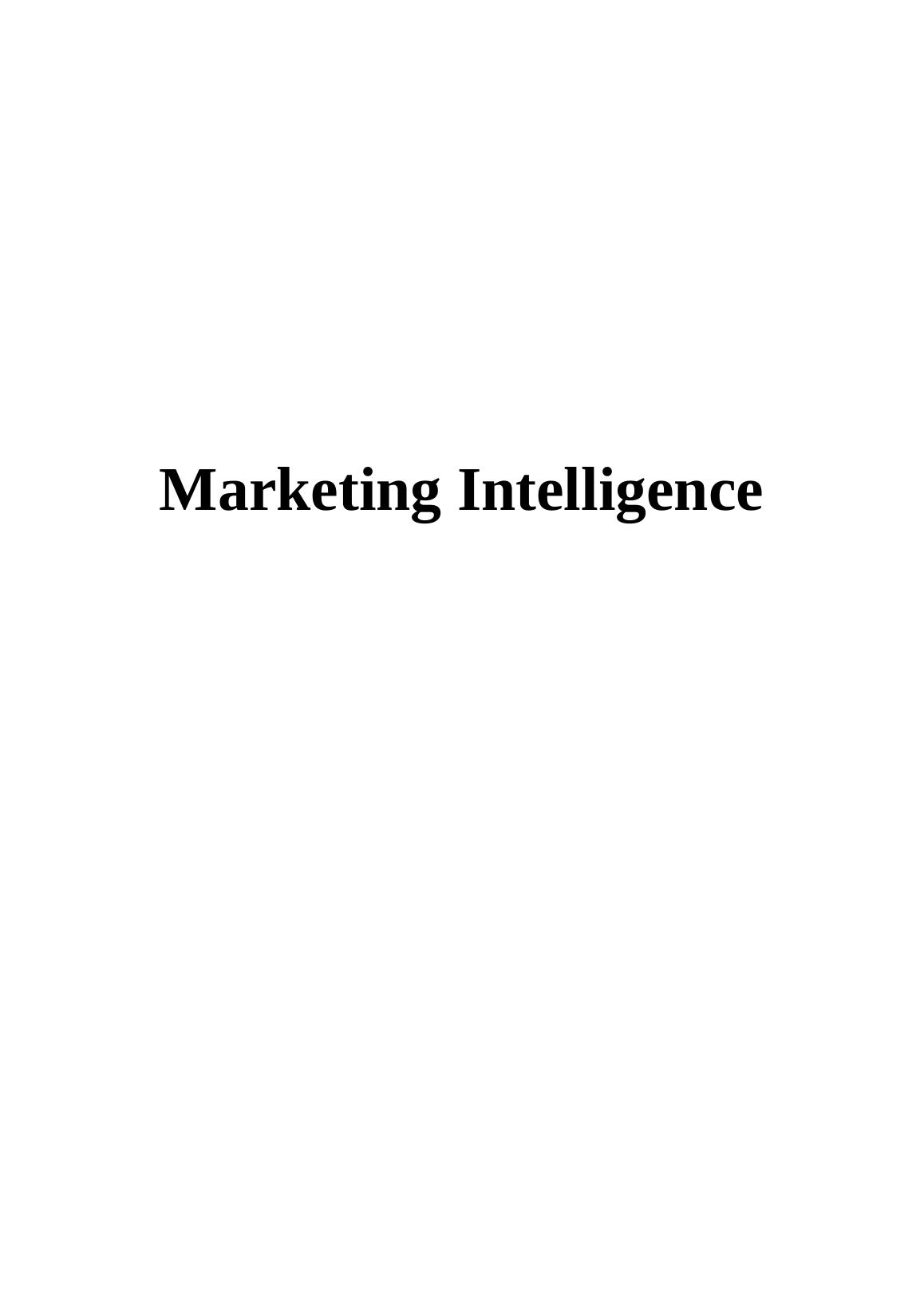
Table of ContentsAssignment 1........................................................................................................................................31.1 Main stages of the purchase decision making process..............................................................31.2 Buyer behaviour theories in terms of individuals and markets.................................................41.3 Explain the factors that affect buyer behaviour.........................................................................41.4 Evaluate the relationship between brand loyalty, corporate image and repeat purchasing.......9Assignment 2......................................................................................................................................102.1 Evaluate different types of market research techniques and prepare a marketing research planto obtain information in the scenario given...................................................................................102.2 Secondary Data........................................................................................................................122.3 Assess the validity and reliability of your market research finding.........................................15Assignment 3......................................................................................................................................173.1 Carry out an assessment of market size trends within a selected market of your choice........173.2 Describe the plan and carry out a competitor analysis for Nokia............................................183.3 Using the selected organisation in 3.2, evaluate the opportunities and threats for a given product or service (3.3)..................................................................................................................21Assignment 4......................................................................................................................................224.1 Evaluate techniques that you will use to assess customer response .......................................224.2/4.3 PRIMARY DATA: Design and complete a customer satisfaction survey for the scenario and review the success of a completed survey .............................................................................23CONCLUSION..................................................................................................................................29References..........................................................................................................................................31Appendix ...........................................................................................................................................34
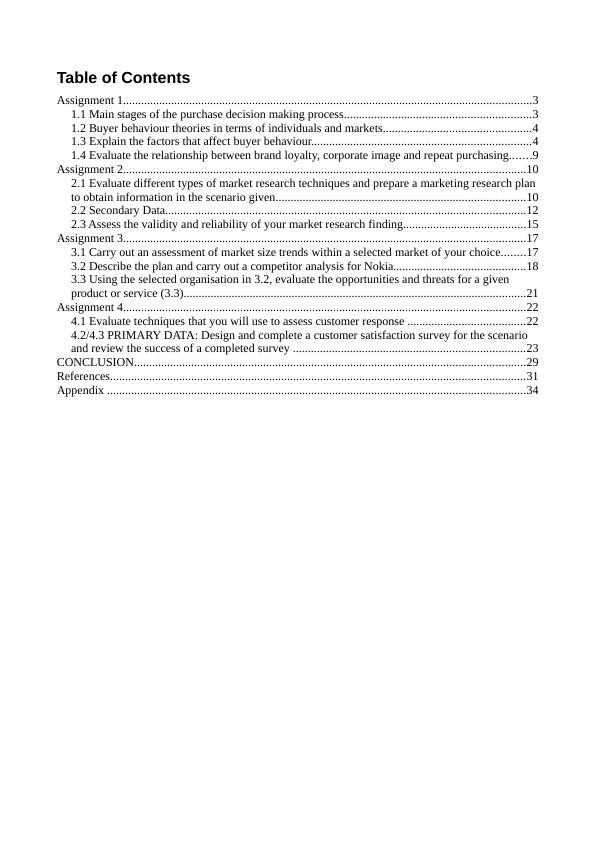
Illustration IndexIllustration 1: Decision Making Process ..............................................................................................4Illustration 2: Sainsbury.....................................................................................................................15Illustration 3: UK Retail sale..............................................................................................................18
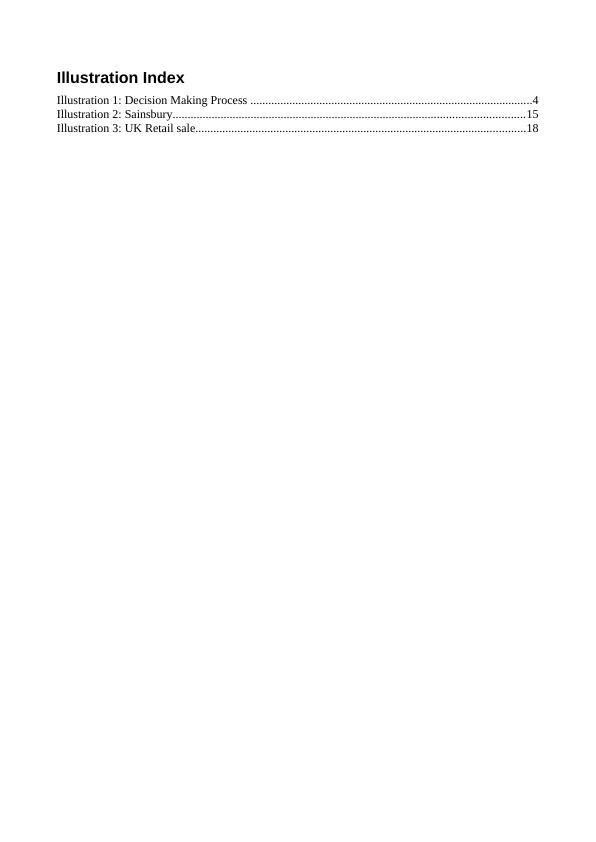
ASSIGNMENT 11.1 Main stages of the purchase decision making process.There are five recognized and used stages in the purchase decision making process (TheConsumer Factor website) and these help a company know how to market a product or service.They can be seen in this diagram:Illustration 1: Decision Making Process Source: (Bryman and Bell, 2015)These recognized stages, with explanations, are:Need/recognition of a problem: In the first stage the consumer comes across a need or aproblem that needs solving. Information search: The consumer then begins the search process. This allows them to findthe item or service which will fulfil their needs or solve their problems. This search takesplace in a variety of places, such as physical shopping, the internet and advertising.Evaluation of alternatives: This stage of the process allows the consumer to compare anumber of alternative solutions. They can use opinions, sales team members and friends togauge the best product or service.Purchase: The purchase stage is the buying stage. The product or service is bought by theconsumer.Post purchase evaluation: This is the evaluation stage where the consumer uses the productor service and decides whether it was a good idea or not.
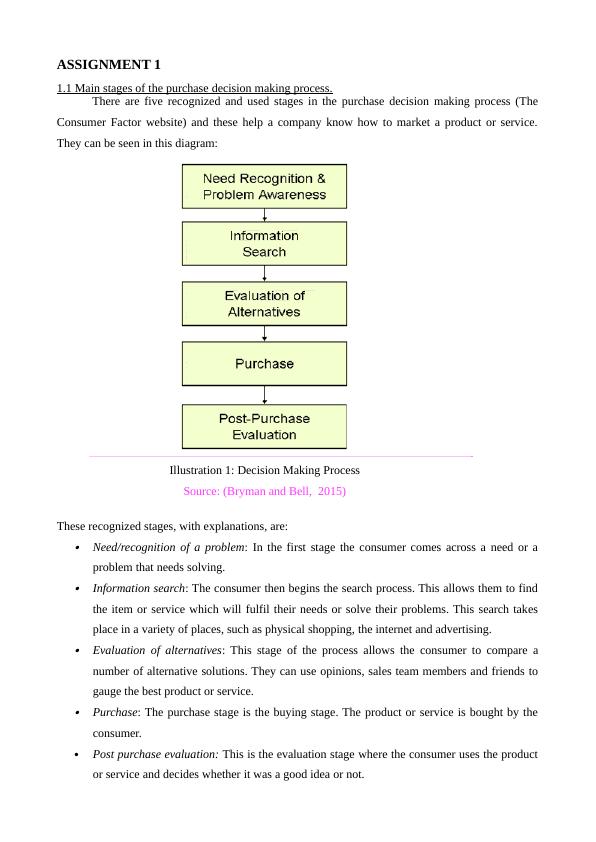
1.2 Buyer behaviour theories in terms of individuals and markets.Three buyer behaviour theories are explained below as-Stimulus Response Model- The model states that buyers characteristics affectshis/her behaviour to purchase an commodity or product. These characteristicsinfluence the decision making process of the consumer for Sainsbury's product.Various factors of personal life, psychology, social life and culture affects the buyersbehaviour towards purchasing products (Lin, Hsu. and Yeh, 2015). Thesecharacteristic are refereed to as response to the market stimulus of product, its price,place and promotion. Buyer decision process responses in coming contact with thesestimulus while purchasing product at Sainsbury.Diffusion and Innovation Theory- The theory developed by E.M. Rogers states that aproduct after its manufacturing reaches to a momentum and state of diffusion in itslife span. Ideas and technology are two factors that generates innovation in theproduct. Diffusion is a process through innovation of a product is communicated tothe consumers. There are four ways to spread information about innovation in aproduct to diffusion and innovation its customers i.e. the innovation, throughcommunication, time and social awareness among the consumers (Festila,Chrysochou and Krystallis, 2014). There are also four phases through whichconsumers accept innovation in the product, which is, innovators phase, earlyadopters phase, early majority phase, late majority phase, and laggards phase.Rational Actor Theory- According to this theory consumer making their buyingdecision based on their rational analysis and self interest. The buying behaviour of aconsumer can be predicted by analysing the importance of the product for theconsumer. Consumers have a different approach when buying products from retailstores, they might rationalise between purchasing more then two products at a timeby analysing the worth of them separately (Manai and Holmlund, 2015). Forexample to purchase a dryer consumer will wait for the old dryer to get broken up.They will, then research and identify the dryer that suits best to their budget.Thus it is evident from these theories that buyer behaviour is different in terms of theirpreference and reaction to the product of the company.1.3 Explain the factors that affect buyer behaviour.
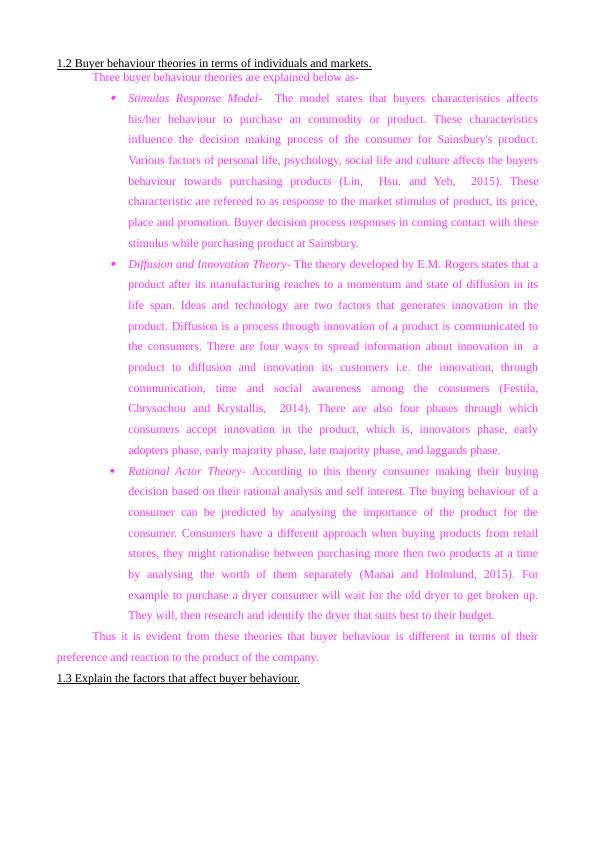
It is believed that buyer behaviour is driven by buying motives, that is, all buying decisionscome as a result of the individual customer’s motives. Motives are different with different people,

but broadly, they fall into the following categories: psychological, socio-psychological,sociological, cultural, and economical. Psychological factors: Psychology is the study of mind and behaviour. In the businesscontext related to buying, this is about understanding how customers think and respond tothe products they buy. Psychological factors are: 1.Drive and Motivation: Drive is a basic force that make people want to do certain things. If adrive has a definite target, then it turns into motivation. Motivation is important to create aeffective business environment in the organisation (Luu, 2014). Drive is a feeling which willtrigger motivational aspect of employee which leads to improved productivity of work.2.Personality and self-concept: Personality represents a combination of a range of traits whichdetermine the way we are, in terms of different ways of thinking, feeling and acting.Personality is what determines what people like and what they dislike. 3.Perception: This is the process of recognising and interpreting sensory stimuli in the worldthat surrounds us. Perception is a ability to understand and perform given objectives andresponsibilities at work place (Poynter, Williams,and York, 2014). The act of perceiving asituation leads to better understanding of the task.4.Learning: Learning is the process in which an individual experiences permanent, lastingchanges in knowledge, behaviour, or way of processing the world. The way people learn iscrucial for marketing communications, as marketers aim at making people understand andremember the message, and as a result, behave in the desired way. 5.Attitude: Attitude is "a relatively enduring organization of beliefs, feelings, and behaviouraltendencies towards socially significant objects, groups, events or symbols" (Hogg, &Vaughan 2005, p. 150). Marketers expect from people to behave in a certain way towardsthe stimuli they send them. As positive attitude towards the organisation will lead to successand achievement at the workplace .Socio-psychological factors: According to the psychologist Gordon Allport, socialpsychology is a discipline which uses scientific methods "to understand and explain how thethought, feeling and behaviour of individuals are influenced by the actual, imagined orimplied presence of other human beings" (Allport, 1985).In simple words, this is the studyof how and why people think, feel, and do everything they do in the circumstances they arein. For example, excessive feelings of competition among colleagues in an organizationleaders to competitive feeling among the employee. This feeling generates frustration andanger towards superiors and subordinates (Raheem and et.al., 2014). In competitivenessemployee tend to judge people in a negative way. They somehow wants to just fulfil theirtargets and objectives and lack courtesy and empathy towards hierarchy prevailing in the
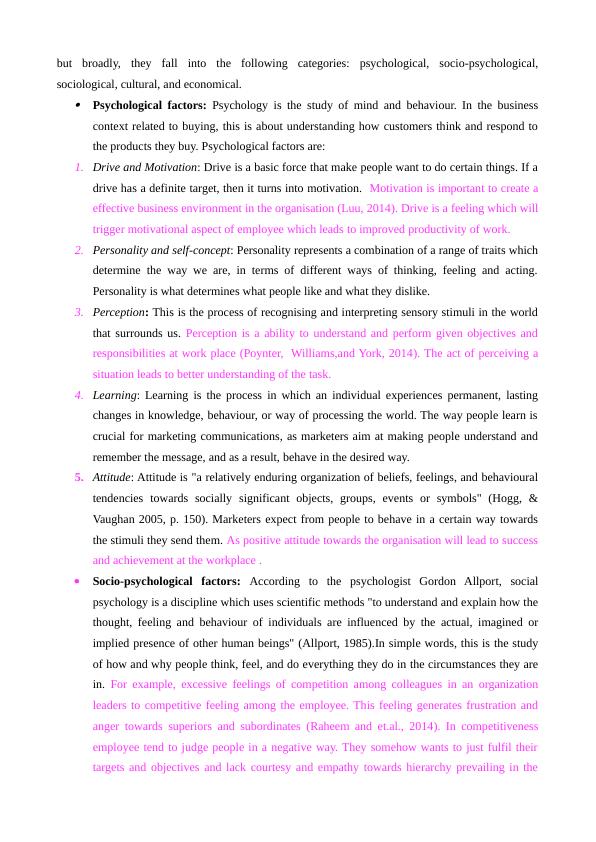
organisation.Sociological factors: Sociology is the study of human society, culture and relationships in agroup context. Man is a social animal, he exists within the group. Therefore, groupbehaviour is important to be studied, to understand what motivates individuals to buy certainbrands and products.1.Peer and reference group: Individuals tend to identify groups which they want to belong to,and the groups they do not want to be a part of. Most groups are associated with a certaintype of consumption.2.Family: It is regarded as the most important reference group as family members have themost powerful influence on an individual. Family members share many items ofconsumption (such as dwelling, food, energy). Besides, the family environment shapes theindividual as a character.3.Class and Culture: Culture is the characteristic features and knowledge of a certain group ofpeople in terms of language, religion, cuisine, social habits, arts, norms of behaviour, etc.Whereas class refers to the difference created by the different income level of the society(San Yapand Yazdanifard, 2014). A superior class person who has a good salary will want toemphasize purchase of item which are highly labellised whereas a person with lower incomegroup will prefer to purchase item that have low monetary significance. 4.Self image and role: One’s image is mostly formed from the feedback from others about theroles we play in life (as children, parents, students, colleagues, etc.).Pretty often, peopledefine themselves by the products they consume. Economic factors: Economics is the study of demand. It is divided in to microeconomics(individual demand, company demand, customer demand), and macroeconomics (economydemand). Economical factors of supply and demand effect the price policy of any productformulated by the company. On the other hand economic choice relates to the ability ofperson to spend money on more then one product (Sargunani and Bruce, 2015).. Forexample, if a customer has already bought a product, he or she is no longer able to spendmoney somewhere else. Elasticity of demand as a economic factors deals in understandingabout those factors other then price that affect the purchase decision of the customer. Theycan be, taste, availability, size, contents and etc.Cultural factors: Culture up to a great extent determines buying habits, it also has effect onthe development, promotion, distribution, and pricing of products. Different consumers fromdifferent parts of the world have different habits, attitudes, responses, values, requirementsand needs. For example, people living in UK demand good clothing product and payattention on variables of tangibility whereas a person living South Africa, who belongs to a

End of preview
Want to access all the pages? Upload your documents or become a member.
Related Documents
Marketing Intelligence in Sainsbury : Assignmentlg...
|15
|4518
|165
Marketing Intelligence Assignment : Tescolg...
|14
|4139
|24
Market Intelligence Techniques and Techniqueslg...
|12
|4002
|488
Consumer Decision Making Process - Assignmentlg...
|22
|5567
|233
Marketing Intelligence Reportlg...
|19
|5695
|420
Different Buyer Behaviour Aspects and Theories | Reportlg...
|15
|4249
|54
